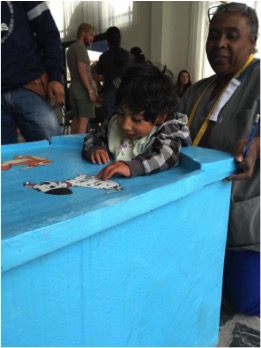Who’s Your Mother?
- Kit Frank
- Aug 1, 2016
- 2 min read
Necessity! When we had to move our adaptive design workshop in Ibarra, Ecuador to a new smaller location, we suddenly realized that we could no longer construct the larger standing tables we had been making because they wouldn’t fit through the door. It was about time to change our design anyway, because the families had difficulty transporting them in a taxi or bus.
Our standing tables are used for children who require significant support to maintain upright posture. We can stand a child in a well-aligned position with laterals, knee padding, wrap-around trunk support, and, if needed, leg separators, elbow blocks, and slight forward inclination. Other children can join in the play from the other side of the table-top. The benefits of standing include better bone and joint health, improved digestion and respiration, development of equilibrium responses and preparation for walking, positioning of the hands for function, inclusion at the level of other children, and more independence in play. The standing tables, all custom-built, are very much in demand in this small city in the Northern Andes Mountains where little adaptive equipment is available.
But how could we be sure that a new design would be stable and safe? Fortunately, some volunteer engineering students from BYU volunteered to redesign. After a week of consultation, computer design, experimentation, cutting, gluing and folding, they made a design that could be easily disassembled, used less cardboard, looked more streamlined, and met all criteria for configuration and safety. BYU Mechanical Engineering student Nolan LeSueur said, “Scott and I loved the strength and durability of the previous model, but families couldn’t fit it in a taxi. Our main objective was not to make a new model, but to make changes to the old model so it would be smaller while still yielding similar strength and durability properties. This was accomplished by cutting down the size and splitting the table into components that could be disassembled to fit into a taxi.”
We now have a formula, based on the child’s height and arm reach, to make it as compact as possible while being stable in all directions.
Samay will join her family at their vending stand from the advantage of a standing position instead of lying down behind the scenes.

About the Author
Kit Frank has 40 years’ experience as an occupational therapist and specializes in assistive technology. She has volunteered with the disability community in Ecuador for 23 years. Kit has led the Adaptive Design Workshop since 2008, providing custom adaptive equipment such as standing tables, adapted seats, trays, easels, and wheelchair adaptations.













Comments